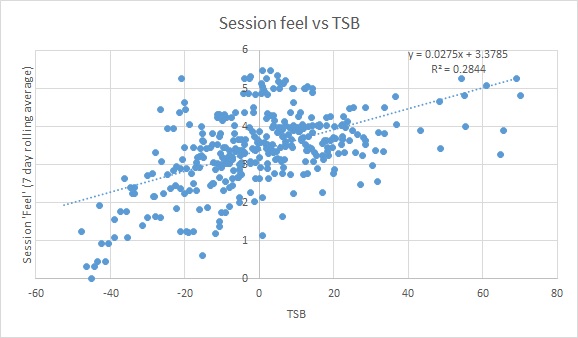When it comes to Periodization,
'Maintenance' isn't a dirty word!
Alan Couzens, M.Sc. (Sports Science)
April 25th, 2017

As you all know, I’m a huge fan of performance modeling. The widespread incorporation of the performance modeling research of Bannister, Morton, Busso & co. in training software & web applications has brought the benefits of dose-response modeling to the masses. For example, Training Peaks now offers all athletes the ability to keep ongoing track of their ‘performance management metrics’ via the PMC chart (located on your athlete dashboard).
While the addition of these metrics that lump all forms of training load from all sports and all intensities into one easily digestible, easily trackable 'training load' number is a huge step forward in quantifying the training dose, it can make it tempting to fall into the trap of chasing the singular goal of pushing that little blue line further and further upward to the exclusion of other very important training objectives.
It is important to remember that in performance terms, CTL is only a part of the picture. It is indeed very possible for an athlete with a lower CTL to race much faster than an athlete with higher CTL due to (among other things) less fatigue in the system & better event specific conditioning. In fact, there will be times in the season that a ‘leveling out’ of the CTL can be a very positive thing when it comes to developing stable, competition specific performance.
Long before the PMC chart came on the scene, the Eastern Europeans were well aware of the benefits of these (CTL flattening) maintenance cycles within the annual plan. In fact, Matveyev, the father of modern periodization divided training blocks into ‘developmental’ and ‘stabilizing’ (maintenance) varieties. Similarly, another forefather in the development of periodization, Vladamir Issurin develops this concept further by dividing blocks of training into ‘accumulation’, ‘transmutation’ and ‘realization’ blocks.
In Issurin's view, blocks should be divided up and sequenced according to different priorities. First, general fitness is accumulated. Then this accumulate general fitness is transmuted or transformed into a more race specific form that the athlete can use in their event & then, in the final block(s), that race specific fitness is realized in actual competitive performance.
Let’s move away from ‘periodization speak’ and better define these terms and our objectives for these blocks:
1. Event specific transfer of fitness:
It’s one thing to be generally fit, it’s another to be fit for a specific task. While keeping the intensity low – with minimal lactate and a heavy reliance on fat oxidation may be the best way to accumulate large volumes of load, if our event is raced at 3 mmol/L of lactate, doing all of our training at 1.5 won’t prepare us for the specific demands. Some training must be done at higher levels close to competition effort and the athlete must be sufficiently fresh to get the training done at these higher levels. The purpose of base is to develop a foundation that we can eventually leverage into training specific to a competitive event. In other words, we want to ‘transmute’ or morph that base fitness into something that resembles our competitive event. For Ironman, base fitness is probably closer to event fitness than a lot of events but it’s still not the same thing. It takes a little time to transform it as Joe alludes in the following tweet.
IM Fitness will prob stabilize in last 6 weeks. High point. After that need to primarily focus on race-specific training, esp limiter/s. https://t.co/gd7YsfPDFw
— Joe Friel (@jfriel) March 6, 2017
2. Stabilization of form:
When you’re tired, the reliability of your performance goes down. This is common sense. We’ve all seen it in the context of big load like training camps. Some days you’re the proverbial locomotive and other days you struggle to be the caboose! In order to have an athlete able to reliably execute to fitness fatigue needs to be low-moderate. I explored this relationship quantitatively in a previous post where I compared TSB with athlete rated session ‘feel’ over a season.

At low TSB/high fatigue, the chances of an athlete rating the session as a 2 (‘not happening’) or a 3 (‘easy was all the legs had today’) goes up. While this may be fine if the objective of the block is to do a high volume of easy training, as we move to programming more and more specific, harder, 'key' sessions, for many reasons - physiological & psychological, we want to maximize our athlete’s chance of getting the session done! And, taking it a step further, when we hit competition time, we want to go as close to possible of guaranteeing that an athlete will be sufficiently fresh to execute to (or hopefully even a little beyond) current fitness. In order to do this, our 'TSB floor' in blocks with important key workouts will need to be a good bit higher than those blocks where we are just concerned with 'getting the miles in'.
As an aside, by tracking HRV, we can often see this stabilization of fitness in the form of stabilization of HRV values (less ‘wiggliness’ of HRV or lower coefficient of variation in more scientific terms). The Plews and Prof provide a really neat case study of this, including data from pro triathlete Dougal Allan here. If you track the deviation of power/HR and pace/HR session numbers. You’ll see a similar pattern, i.e. a trend towards stability as CTL flattens. In terms of predictable performance on race day, this is a very good thing!
Both of the above objectives will demand that we back off a little in the pure accumulation of training load and turn our attention to other objectives. Or, in PMC terms, that we become ‘OK’ with seeing that blue CTL line level out a little as we get closer to the event – to better guarantee our ability to get the most from the most important key sessions leading into the A Race and, more importantly, to maximize our ability to get the most from our fitness at the A Race. Potential fitness doesn’t count for much compared to what the clock says when you cross the line.
While it can be tempting to want to address both of these objectives in the final 2 or 3 blocks as we approach the key race, in my experience, it rarely works out. Going along with our bunny theme….
“He who chases 2 rabbits catches neither”
I.e. that athlete is often too tired to give key sessions the intensity they deserve but overall volume/load is curtailed by their presence.
So, what’s the solution?
In order to address both goals of building general fitness and having sufficient energy to build specific fitness for the event, I would recommend dividing blocks into ‘development’ or ‘accumulation’ blocks and ‘stabilization’ or ‘transmutation’ blocks in the same manner that Matveyev and Issurin did. A 6 month cycle leading up to an Ironman may look like the following…
| Month | Jan | Feb | Mar | Apr | May | June |
| Phase | General | General | Specific 2 | General | IM Prep | Comp |
| Type | Dev. | Dev. | Stab. | Dev. | Stab. | Peak. |
‘Transmutation’/Stabilization blocks should be concentrated towards the end of the year, as they have a shorter time course of training adaptation than the basic qualities, but not necessarily successively. One of my favorite sequences for Ironman athletes that I work with is 1 of these blocks of race pace training followed by one final ‘accumulation’ fitness boost with a big camp week prior to the last key specific sessions of the build prior to taper.
Whichever way you play it, as athletes back off just enough to let the CTL curve flatten a little and you begin to realize the fitness built in the base blocks in real world, key session terms, you’ll both agree – maintenance isn’t a dirty word.
Train smart,
AC
TweetDon't miss a post! Sign up for my mailing list to get notified of all new content....

